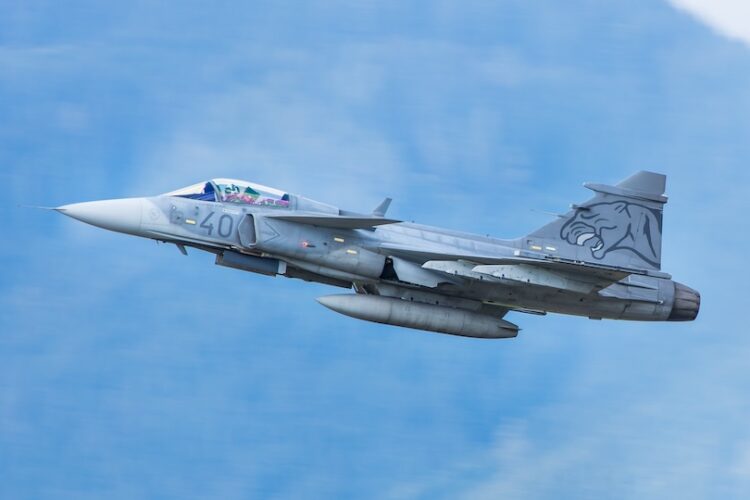Canadian Prime Minister Mark Carney has argued that Canada ought to take into account buying the Saab Gripen as a substitute of the F-35 as a result of doing so would cut back American leverage over Canadian protection coverage. The thought has been repeated by numerous Canadian commentators and coverage wonks who declare the buying the F-35 compromises Canadian sovereignty, whereas buying the Gripen affords strategic autonomy. This argument sounds interesting—till you spend 5 minutes really taking a look at how the protection industrial base and associated provide chains work in the true world. When you try this, the notion that the Gripen affords geopolitical independence is revealed for what it’s – not simply nonsense, however nonsense upon stilts.
The Gripen has all the time loved a sort of underdog status. Light-weight, agile, cheaper than its opponents, it’s been held up because the sensible alternative for international locations that don’t need to be caught within the gravitational pull of Washington or Brussels. On paper, it seems to be nice—trendy sensors, digital warfare capabilities, STOL efficiency, and the power to function from distant or improvised airstrips. It’s straightforward to see why it has its followers. None of that adjustments the truth that the Gripen E runs on an American engine: the Basic Electrical F414-GE-39E. This is similar engine that powers the U.S. Navy’s Tremendous Hornet. It’s made in america and topic to the identical American export controls as another U.S.-manufactured navy element. Meaning Washington can veto any Gripen sale, to any nation, at any time. And it has.
In early 2025, Colombia was getting ready to accumulate the Gripen E. Saab’s provide was sturdy—cost-effective, technically succesful, and tailor-made to Colombia’s airspace and operational wants. They even included incentives to construct up native business. However because the deal neared finalization, phrase leaked that the U.S. authorities supposed to dam the export of the F414 engine. And identical to that, your entire factor collapsed. That wasn’t a bureaucratic delay or a paperwork challenge. It was Washington exercising its authorized authority beneath the Worldwide Visitors in Arms Rules—ITAR—and it killed the deal.
This isn’t a one-off. India’s Tejas MkII, which additionally makes use of the F414, is beneath the identical set of export restrictions. So is Brazil’s Gripen program. Even when these jets are assembled in São Paulo as a substitute of Linköping, Washington nonetheless will get a say in the place they are often bought. Each plane that depends on a U.S.-made element—particularly one thing as important as an engine—is, by definition, not totally sovereign.
The notion that Canada can by some means sidestep American affect by selecting the Gripen over the second batch of F-35s is pure fantasy—particularly since Ottawa has already purchased and paid for the primary 16 of the deliberate 88 fighters. Each jets depend on the U.S. protection industrial base. Each are enmeshed in American provide chains. Each are constrained by ITAR. The one actual distinction is that the F-35 comes with built-in integration with NATO allies, frequent logistics, and a sturdy sustainment pipeline, whereas the Gripen comes with extra isolation—and affords no extra autonomy.
Sweden has all the time taken pleasure in its impartial protection posture. Saab is a logo of that custom—a Chilly Conflict legacy of neutrality backed by credible indigenous manufacturing. However that mannequin doesn’t scale cleanly into the twenty first century. Fighter jets as we speak are complicated, multinational techniques. Nobody builds every part in-house anymore. And Saab’s choice to make use of an American engine in its flagship export fighter successfully handed the U.S. a veto over its gross sales. It’s a call that made sense from a technical and value perspective, however it got here with political penalties.
What’s putting is how many individuals in Ottawa—and now within the Prime Minister’s Workplace—don’t appear to grasp this. Protection coverage isn’t nearly choosing a platform. It’s about understanding the ecosystems these platforms are embedded in. The F-35 could include an enormous sticker value, however at the least it comes with a community. The Gripen doesn’t purchase you sovereignty; it buys you the phantasm of it. You’re nonetheless depending on Washington’s permission slip, solely now you don’t have the operational advantages that include being contained in the tent – and fielding the superior fighter.
That is the larger drawback with the Gripen argument. It displays a sort of magical considering that’s far too frequent in Canadian protection debates: that we will by some means purchase sovereignty off the shelf, that the appropriate procurement choice will free us from the realities of our alliances and dependencies. That’s not how any of this works. If Canada needs actual strategic autonomy, it’s going to need to put money into its personal industrial base. Meaning propulsion, munitions, sustainment, and techniques integration. And that’s merely by no means going to occur. The phantasm that Canada can obtain the identical purpose just by choosing a Swedish jet – one powered by an American engine – will not be merely an phantasm, it’s a delusion.
The reality is uncomfortable however simple. Canada’s airpower is, and for the foreseeable future can be, tied to the American protection industrial based mostly and due to this fact topic to American legal guidelines and rules. That’s not a bug—it’s a function of the Western defense-industrial ecosystem. The F-35 makes that relationship express. The Gripen obscures it, however it doesn’t change it.
Prime Minister Carney’s suggestion that buying the Gripen as a substitute of the F-35 will hold Canada out of Washington’s clutches is just not credible. Worse, it promotes a false sense of freedom the place none exists. If Ottawa goes to take protection significantly, it must deal in strategic actuality—not romantic myths about neutrality and independence that had been out of date a technology in the past. Canada doesn’t want one other grand gesture. It wants functionality, readability, and a protection coverage rooted in how the world really works.
Additional Studying on E-Worldwide Relations












